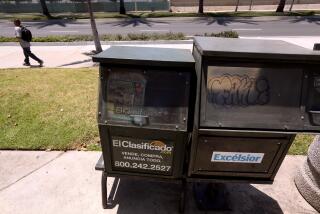Channel 13 Struggles to Redo the News : Television: After five years of directing the station’s coverage, Jeff Wald says it’s improved despite problems.
- Share via
Five years and millions of dollars later, all Jeff Wald has to show for his experiment in creating a local newscast for the “Star Trek” generation is a reputation as the station with “the newspeople who stand up.”
At least that’s better than “the newspeople who walk around,” which is what the anchors used to do--aimlessly, pointlessly, Wald admits--when KCOP-TV Channel 13 unveiled its much-delayed, multimillion-dollar newsroom and attempt at a hip-but-serious news style nearly two years ago.
But that’s the cynic’s view, Wald insists now, just months before his five-year contract as KCOP’s news director is set to expire.
“When I arrived, we were the also-rans, a rip-and-read operation practically in the Stone Age technologically, and so we have tried to reinvent TV news, and that is not an easy thing to do,” Wald said. “It takes time to build credibility and a news franchise, and I knew that coming in. We had no illusions about some quick fix. And if you look at us now, we’re light years ahead of where we were. We’ve grown from maybe 30 to 75 people, and the quality of the program is immeasurably better. So from a station that was essentially invisible, we are certainly on the map. My only regret is that we are not doing more news on the air.”
*
In fact, they’re doing less. When Wald arrived, KCOP offered an hour of news each weeknight at 10. But having made no headway against the news competition on KTLA-TV Channel 5, KCAL-TV Channel 9 and KTTV-TV Channel 11, KCOP cut back to a half-hour newscast earlier this year in an effort to provide an alternative. Every other VHF station in town produces at least three hours of news each weekday.
“Believe me, that decision was very hard for me to take,” said Wald, who before landing at KCOP served as news director at top-rated KTLA.
Wald had hoped that the lost half-hour at 10:30 would become a newsmagazine produced by his department. But that idea has been put on hold, replaced by syndicated late-night programming.
In a sense, it comes down to a battle of the idealism of a serious news junkie who’d like to put on as many hours of news a day as he can and the practicality of running a TV station that was the last of the seven VHF stations in the market to dive deeply into the news game.
KCOP, which will become part of the new United Paramount network in January, has been doing well both in daytime and prime time with first-run syndicated programs such as “The Ricki Lake Show” and “Star Trek: Deep Space Nine,” which are aimed at young adults--a demographic prized by advertisers. Those viewers supposedly don’t watch TV news as much as older viewers, for whom advertisers don’t pay as much to reach.
Initially, KCOP management thought it could distinguish itself from the competition and grab younger viewers with a jazzy, high-tech newscast that featured reporters walking around the two-story newsroom, splashy graphics and longer-form mini-documentaries. But better ratings never materialized.
Rick Feldman, the station’s general manager, believes the effort was worthwhile, though he admits it will be a long time before KCOP recoups the huge investment it has made in news over the past few years. In the short term, however, Feldman said that the newscast is not yet bringing in enough ad revenue to cover the annual news budget, so Wald has been asked to trim his costs a bit.
*
But what about image? TV executives have long purported that localism, especially local news, is vital to a station’s identity, one of the only ways a station can stand out in a TV environment that features scores of viewing options--and KCOP’s 2 1/2 hours out of a 168-hour television week, Wald believes, are not enough to make an impression.
Feldman, however, is a convert to a different philosophy.
“Identity is important, but it doesn’t have to be local,” Feldman said. “I think we’ve come to a point where there is just too much local news. What good does it do anyone having every single station on O. J. Simpson in court with the same camera? To me, identity comes from putting on programs that people want to watch. . . .
“We want people to watch us for news, but it’s really just another one of our programs, something we do to make our station whole. But it’s not a signature item. We’re all going to have to live with that.”
Feldman insists that the station is not going to choose to live entirely without news, however. He hopes to produce the local newsmagazine at some point. He is not against creating a newscast during the day that doesn’t have direct competition from another local station--a move Wald has been advocating to help amortize the cost of the news equipment and personnel. But Feldman said he will wait to see how his syndicated programs fare this fall before making any moves in news.
“It’s silly to think you don’t want to do news at all,” Feldman said. “It does give you a presence in the neighborhoods with reporters and trucks. That’s a big asset. But we just can’t look at it as the single thing that creates your image or necessarily brings in your big profits.”
More to Read
The biggest entertainment stories
Get our big stories about Hollywood, film, television, music, arts, culture and more right in your inbox as soon as they publish.
You may occasionally receive promotional content from the Los Angeles Times.










